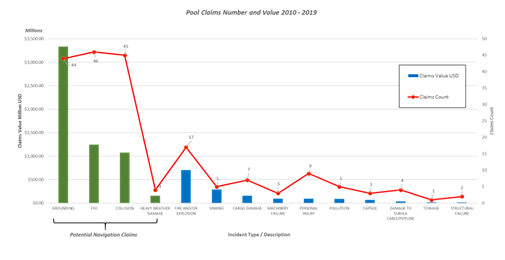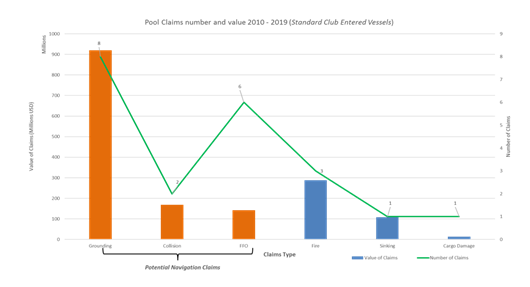Over the last 10 years there has been a general increase in the number of claims which relate to the broad description of navigational incidents. These include groundings, collisions and contacts with fixed and floating objects (FFO). Thus, Mr. Clive Rees, Senior Surveyor, the Standard Club notes that the numbers of the relevant pool claims, named because the costs of those claims exceed the retention levels of the individual P&I clubs, are as follows: – grounding 44, collision 45 and FFO 46.

The share of those incidents attributable to the Standard Club, along with the costs incurred are; groundings – 8 with costs in excess of USD 920 million, collisions – 2 with costs in excess of USD 142 million and FFO – 6 with costs in excess of USD 168 million.

It can be said that these claims tend to be more expensive, widely covered in the media and always a corporate embarrassment.
Navigational incidents occur as a result of a failure of the master and/or officer of the watch to apply basic traditional navigational procedures and discipline. Regarding collisions, these include errors such as failure to maintain a proper lookout using all available means or failure to determine if risk of collision with other vessels exists. These casualties also occur when the responsible persons fail to take appropriate actions in a timely, seamanlike manner in accordance with the collision regulations. In brief, any person who is responsible for the safe conduct of the vessel must have a clear and accurate understanding of the vessel’s situation, the traffic around it and the operational status of the navigational equipment and main engine at all times. That responsible person must always act timely and decisively.
Safe navigation
The techniques for safe navigation are widely known; when mastered and professionally applied, navigational risks can almost be eliminated. We know, however, that any shortfall in performance increases the risk of an incident. That is why there is pressure in the industry for audits of masters and deck officers to verify that their competencies, behaviours and collective performances are satisfactory. The reasons why procedures are not followed are varied and may not only be due to a lack of knowledge or competence. They also may lie in the workloads and pressures that ship’s officers experience frequently today.
The purpose of a navigational audit is to check the bridge team’s preparation, planning and practices when navigating, to identify and mitigate any risks to the safe navigation of the vessel. Examples of such risks include non-compliance with the collision regulations, the use of insufficient suitable scaled navigation charts for the voyage being undertaken, use of out of date or uncorrected charts and publications, and poor practices. Other areas of concern may include the lack of necessary experience and inadequate knowledge amongst the deck officers or master, lack of maintenance and testing of essential equipment for navigation and its proper use, lack of compliance with the company’s ship management system etc.
Assessors and Auditors
Company assessors / auditors should be experienced master mariners who possess the necessary knowledge and skills and who have had specific technical training in conducting navigational audits. Navigation is a dynamic process, so assessors / auditors should have sufficient competence and experience in using the latest technology. They should be well versed in the company’s implementation and practical applications of navigational procedures in their fleet.
We believe that the physical presence of an experienced and trained assessor / auditor is crucial during the audit process, in order to observe and record the aforementioned risks. This period on board does not require a lengthy stay. A few days would be sufficient to observe the actual performance, motivation and attitude of the watchkeepers, how they act, how they react to situations and, more important, how they are distracted from the immediate task of conducting the ship safely. We appreciate the economic and logistical benefits of remote audits, but we wonder if this option captures all of the actual behaviours of the personnel during their watch periods on the bridge, particularly during close quarters traffic situations while approaching pilot stations or berths. Our own research and observations during such audits support this assertion clearly.
The audit
The typical navigational risk review has two phases, static and dynamic, where the static section can be completed whilst the vessel is in port. The static phase covers a review of the company policies, a detailed examination of the passage planning process, an assessment of the operational status of the bridge equipment and an examination of any other relevant instructions, notices, or forms and checklists that are in use on board. The dynamic phase, conducted while the vessel is proceeding on passage, is where the auditor observes and records what actually happens on the bridge and assesses the degree of compliance with the company’s policies and the standard of bridge watchkeeping/general navigation and pilotage displayed by the watchkeepers.
A navigational risk review carried out while the vessel is proceeding on a voyage allows proper judgement on how successful the bridge team management is and what improvements are needed. The assessor/auditor should look at the bridge team’s familiarity with the bridge equipment, communication equipment and emergency distress procedures, navigation procedures, emergency/contingency plans, company forms, company documentation and company checklists.
In practice, this means that during the risk review, the bridge watchkeepers must show their competence and confidence in how to operate all the equipment and must know the bridge and the control console thoroughly. The auditor will have a particular interest in learning how familiar the deck officers are with the menus and various control settings of the ECDIS and radar equipment. Our experience and research show that many mariners are not as familiar with important settings as they should be. More importantly, they are frequently unaware of their own lack of knowledge.
The assessor will be observing closely for clear evidence of good situational awareness amongst the bridge team members when navigating in a reporting area, or designated risk area, or where the security level has been raised. This alertness is essential to timely identification of a threat and effective protection of the ship.
During the navigational risk review, the questions of how and when the master spends time with their officers, mentoring, should also be assessed. This training and guiding role is a crucial element of a Master’s job description today.
All parties involved should understand that navigational risk reviews are not designed solely to find faults and poor practices. Their most important objective is to assist the mariners and their companies to identify where weaknesses are present and where improvements could be made to their navigational procedures.
Summary
We believe that significant numbers of major, headline-generating navigational incidents can be prevented by effective navigational risk reviews (audits) which assess how the actual navigation of the ship is conducted. These audits are best carried out by experienced and specially trained master mariners who are physically present during passages between ports. A diligent navigational risk review where the auditor can enjoy a trusting and respectful relationship with the Master and deck officers, will result in a positive experience for all concerned. It also follows that when diligent corrective action is taken to address any identified weaknesses, positive improvements in operating performance and safety standards should result.
The views presented hereabove are only those of the author and not necessarily those of SAFETY4SEA and are for information sharing and discussion purposes only.
About Clive Rees
 Mr. Clive Rees, Senior Surveyor, Master Mariner and Marine Surveyor, has over 30 years sea-going experience in all ranks on Bulk Carriers, General Cargo and Tanker vessels, with over 18 years as Master on Cape and Gearbulk carriers and General Cargo vessels. Mr Rees has extensive ship-handling experience in a variety of different sized vessels and extensive experience in the loading, carriage and discharge of a wide range of Bulk and Break Bulk Cargoes, and a long experience in the on-board training of British and Filipino Deck Cadets. His experience includes embarkation on fixed trading routes as well as worldwide tramping voyages via the Panama Canal, Suez Canal, through the Strait of Magellan, the Malacca Straits and around the Cape of Good Hope. He has worked as a Marine Consultant for LOC, while he joined Charles Taylor in January 2014.
Mr. Clive Rees, Senior Surveyor, Master Mariner and Marine Surveyor, has over 30 years sea-going experience in all ranks on Bulk Carriers, General Cargo and Tanker vessels, with over 18 years as Master on Cape and Gearbulk carriers and General Cargo vessels. Mr Rees has extensive ship-handling experience in a variety of different sized vessels and extensive experience in the loading, carriage and discharge of a wide range of Bulk and Break Bulk Cargoes, and a long experience in the on-board training of British and Filipino Deck Cadets. His experience includes embarkation on fixed trading routes as well as worldwide tramping voyages via the Panama Canal, Suez Canal, through the Strait of Magellan, the Malacca Straits and around the Cape of Good Hope. He has worked as a Marine Consultant for LOC, while he joined Charles Taylor in January 2014.































































